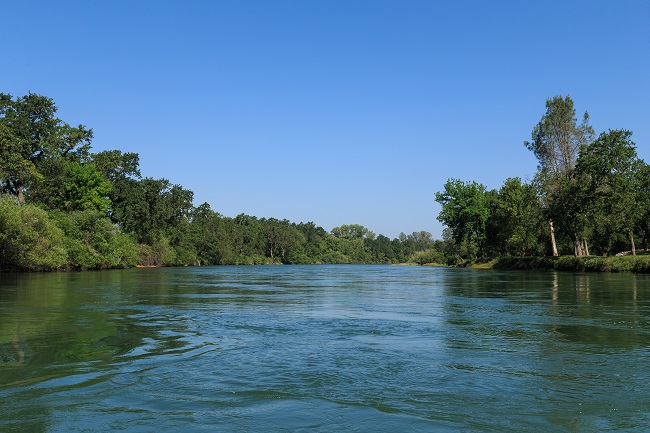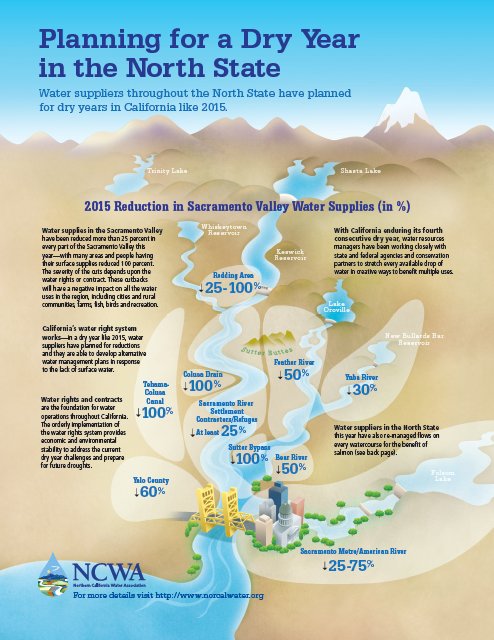Every year in water is different. In this fourth consecutive dry and warm year, the spotlight is on the dynamics surrounding the Sacramento River Temperature Plan, which has emerged as a major challenge for water resources, fishery and refuge managers. The effects of implementing the plan are being felt directly along the Sacramento River, as well as indirectly in other parts of the Sacramento Valley and entire state.
As background, a significant operations agreement for the Sacramento River was approved earlier this spring by various federal and state agencies. Recent information has shown that, due to faulty temperature probes, the water temperature in Shasta Reservoir is higher than originally projected. This led the agencies to revise the temperature plan for 2015. Perhaps most important, the agencies’ new flow proposal will limit releases below Shasta Reservoir to 7,250cfs to preserve cold water in the reservoir for later in the year. This new flow path represents an approximate 20% reduction in flows from the original operations agreement during July, and will severely impact water deliveries within all regions of the Central Valley Project (CVP). By the integrated nature of the system, the impacts will also spread to other parts of the Sacramento Valley. The key components of the plan can be seen at: Bureau of Reclamation – Latest Drought Info.
Throughout the Sacramento Valley, water resources managers continue to work with federal and state agencies to actively manage water resources for multiple beneficial purposes that include water for cities, rural communities, farms, fish and wildlife and their habitats. Importantly, as shown on the “Planning for a Dry Year in the North State,” water supplies have been reduced more than 25 percent in every part of the Sacramento Valley this year—with many areas having their surface supplies reduced 100 percent. These cutbacks are having a negative impact on all these beneficial uses in the region.
On the Sacramento River, the Sacramento River Settlement Contractor’s (SRSC’s) diverted less than 75% of their total contract supply in 2014. Similarly, this year the SRSC’s will more aggressively manage their water supplies to address the extraordinary drought conditions. In addition, the SRSC’s have made arrangements to transfer twice as much water as 2014 to provide critical water supplies to areas of need in California. The revised plan may further decrease diversions by approximately 20% in the critical crop and terrestrial habitat irrigation month of July. If the Sacramento River goes too low, it is even possible that existing crops and habitat may not have water. In response to the revised plan, the SRSC’s will be taking further action to stretch available supplies to meet demands, which may include increased groundwater pumping consistent with the emergency authority approved by the Governor this year.
On the Feather River, water suppliers have been cut to 50% of their contract supplies. By reducing releases from Lake Shasta, there will be increased pressure on Lake Oroville to provide water for the Delta. It is anticipated that Lake Oroville will be at 900,000 acre-feet by the end of October, which will place additional burdens on the Feather River and the State Water Project later this year.
On the American River, the urban water users reduced their May demand by nearly 45% in 2015 compared to 2013. Here, Folsom Reservoir is expected to be at 120,000 acre-feet at the end of September, which creates risk that the CVP will be unable to provide water for many of the metropolitan water suppliers that depend upon water from Folsom Lake.
Additionally, throughout the region, the State Water Board has issued curtailment notices that will affect surface water suppliers that do not already have water in storage or a contract for an available water supply. In all areas, farmers and refuge managers are planning a variety of ways to cope with this shortfall, including fallowing fields, shifting to lower water use crops, and utilizing groundwater where available.
Even with the creative actions that are underway throughout the region to get through this year, it appears that more flexible operations will be necessary this summer than proposed by the agencies, including increased releases from Shasta Reservoir during certain parts of July, when all the demands on the water system converge. This will be important to limit the impacts on all of these beneficial purposes in the Sacramento Valley, as well as providing critical water supplies for other parts of the state. In this regard, aligning the releases under the operations plan to achieve multiple beneficial uses will be particularly essential in July to get through the year.
North State water resources managers and growers have been working hard to maintain the maximum amount of water for area growers and the environment throughout the Sacramento Valley. With California enduring its fourth consecutive dry year, every drop of water counts and must be stretched as far as possible to benefit multiple uses.

The water suppliers throughout the region will continue to diligently work with our conservation partners to advance the Sacramento Valley Salmon Recovery Program and to maximize water supplies for bird habitat along the Pacific Flyway. The water supplies in all parts of the Sacramento Valley are very tight–this will continue to be an extremely challenging year as we manage and safeguard this precious resource.




